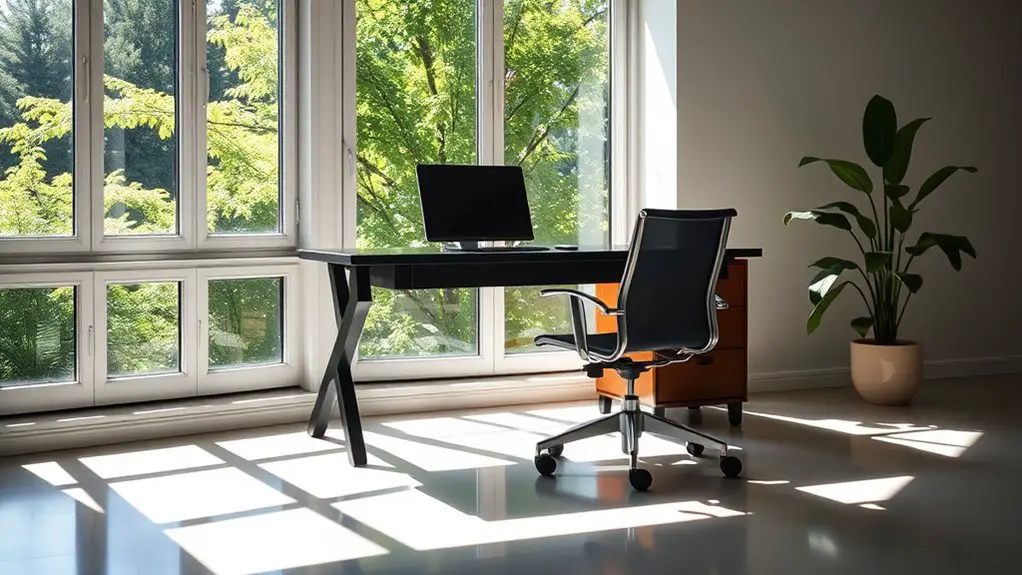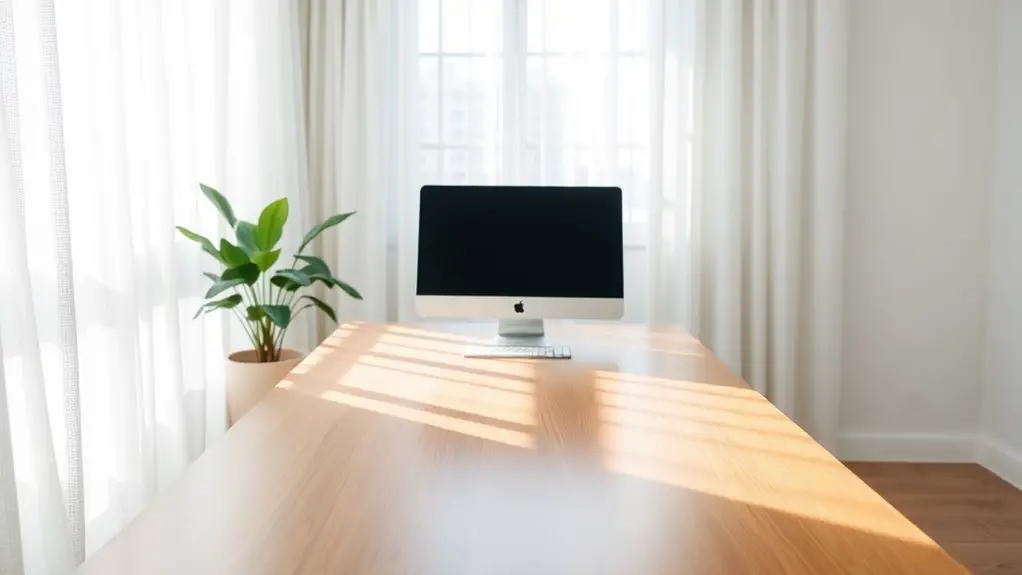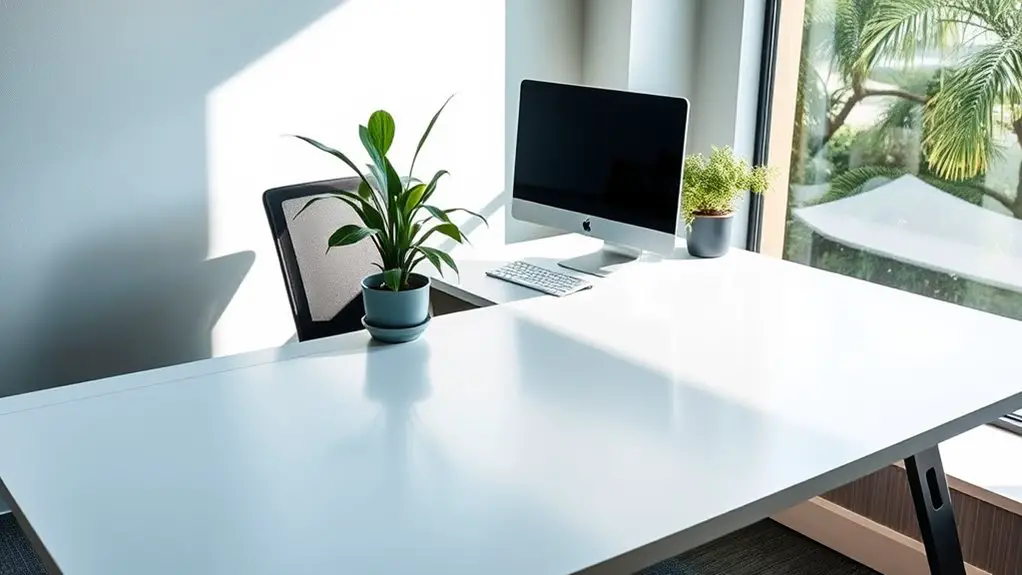To position your desk and avoid glare and shadows, place it near a window, but at an angle to allow natural light without direct glare. Use window coverings like solar shades to control brightness. Confirm your monitor is centered and slightly tilted back, while also adjusting task lighting to eliminate reflections. Keep your workspace organized to minimize distractions. For more tips on enhancing your workspace and maintaining eye health, you might find the following suggestions useful!
Table of Contents
Key Takeaways
- Position the desk perpendicular to the window to reduce direct glare while benefiting from natural light.
- Use window coverings, like solar shades or blinds, to control light levels and minimize reflections on screens.
- Align the monitor with natural light coming from the side, keeping it at eye level to avoid neck strain and glare.
- Adjust task lighting to match ambient light, ensuring illumination without causing reflections on the monitor.
- Regularly assess and organize your workspace to eliminate clutter that can create shadows and distractions.
Choosing the Right Desk Location

When choosing the right desk location, it's crucial to evaluate how natural light can enhance your workspace. Position your desk near a window, but don't face it directly. Instead, place it to the side for better light distribution. This setup reduces the need for artificial lighting and minimizes shadows and glare.
Consider your dominant hand, too—if you're right-handed, place your desk lamp on the left side to avoid casting awkward shadows while you work. Verify your light sources are shielded to prevent glare on your computer screen, and use supplementary lamps for focused tasks. Additionally, ensure your lamp has adjustable features to direct light precisely where you need it.
With proper orientation and lighting, you'll create a comfortable, productive work environment that enhances your efficiency.
Adjusting Window Coverings
To effectively control glare, you need to contemplate the types of window coverings that best suit your workspace. Options like solar screen shades and sheer fabrics can reduce UV rays while still letting in natural light. Proper window treatments help in creating a pleasing atmosphere, which is essential for maintaining focus and productivity. Adjusting these coverings throughout the day can help you maintain a comfortable and productive environment.
Types of Window Coverings
Choosing the right type of window covering can make a significant difference in managing light and enhancing your space. Here are some popular options to evaluate:
| Type | Benefits | Materials |
|---|---|---|
| Roller Shades | Adjustable light control | Various fabrics |
| Roman Shades | Excellent privacy and style | Patterned fabric |
| Sheer Shades | Ample natural light, some privacy | Soft fabrics |
| Blinds | Precise light control | Wood, faux wood |
| Cellular Shades | Energy-efficient and glare-reducing | Honeycomb fabric |
In addition to these options, shutters provide a classic design staple in home decor while allowing for customizable light control.
Optimal Adjustment Techniques
Window coverings play an essential role in managing natural light and reducing glare, but knowing how to adjust them effectively can enhance their benefits. Start your day by using lighter, sheer curtains to diffuse morning sunlight, maintaining visibility without harsh glare. As the sun rises higher, switch to heavier blinds or shades to block intense afternoon light. Additionally, consider using specialized fabrics that can reflect and diffuse sunlight effectively for even greater glare reduction. In the evening, adjust your coverings to let in more light or use thicker materials for privacy. Remember to take into account seasonal changes in sunlight direction and intensity, adjusting accordingly. For convenience, automated solutions can be programmed to adapt throughout the day, optimizing glare control without constant manual adjustments. Consulting professionals can also provide tailored advice for your specific space.
Optimal Monitor Placement

Optimal Monitor Placement
Positioning your monitor correctly is essential for minimizing glare and enhancing comfort during prolonged use. To reduce glare, make certain natural light comes from the side, keeping your monitor at a right angle to windows or other light sources. Consider using curtains or adjusting bright lights when needed. The top of your monitor should align with or be slightly below your eye level to prevent neck strain. Keeping monitor position at least an arm's length away ensures clear viewing and comfort. Center your monitor directly in front of you to avoid twisting your neck. Finally, tilt your screen slightly back—about 10° to 20°—to further reduce glare and enhance your viewing experience.
Setting Up Task Lighting
To set up effective task lighting, you need to focus on ideal lamp placement that avoids glare while providing direct illumination. Consider adjustable brightness options so you can tailor the light intensity for different tasks. Additionally, matching the color temperature of your task light to your workspace can enhance comfort and productivity. Ergonomic lighting is crucial for maintaining a healthy office environment, as it can significantly reduce symptoms like eye strain and headaches.
Optimal Lamp Placement
Effective lamp placement is essential for creating a well-lit workspace that minimizes glare and shadows. Position your task lighting to illuminate your work area without casting shadows. Ideally, choose adjustable desk lamps or swing-arm lamps that can be directed to the task at hand. Place the light source at eye level or slightly above, ensuring it's angled away from your eyes to reduce glare. Additionally, proper positioning of task lighting can enhance focus on specific tasks, further improving productivity. Maintain a distance between the lamp and your workspace to allow for even lighting. If you use multiple monitors, consider swing-arm lamps for flexibility.
Adjustable Brightness Options
Finding the right lighting setup doesn't stop at ideal lamp placement; adjustable brightness options can greatly enhance your workspace.
With customizable task lighting, you can tailor the light intensity for specific activities like reading or computer work. For example, using 450-700 lumens is ideal for general tasks, while 700-1000 lumens suits reading or writing. Selecting appropriate lumens prevents eye strain and enhances productivity.
Modern lamps often offer multiple modes to help you adjust brightness based on the time of day or task. This flexibility not only boosts your work efficiency but also reduces eye strain by minimizing glare and shadows.
Color Temperature Matching
Selecting the right color temperature for your task lighting can greatly impact your productivity and comfort. Warmer temperatures create a cozy atmosphere, while cooler temperatures boost alertness, making them ideal for focused tasks. Here's a quick guide to help you choose the right color temperature for various tasks:
| Task | Recommended Temperature | Ambiance Effect |
|---|---|---|
| Office Lighting | 3000-4000K | Productive |
| Bedroom Lighting | 2700K | Relaxing |
| Kitchen & Bathroom | 5000-8000K | Detailed visibility |
| Reading/Home Office | 3000K | Comfortable focus |
Incorporating CCT technology into your task lighting can enhance your environment by allowing you to adjust the color temperature to suit your specific activities and preferences.
Managing Natural Light
Since managing natural light is essential for a productive workspace, positioning your desk strategically can greatly enhance your comfort and focus.
Place your desk near a window, angling it slightly to let light in from the side, which helps reduce glare on your screen. Opt for light-colored furniture and walls to reflect and diffuse natural light, creating a brighter atmosphere. Light-colored furniture effectively reflects light, further enhancing the overall brightness of your workspace.
Avoid direct sunlight on screens to minimize eye strain. Consider using window shades to control light levels and prevent reflections.
Additionally, choose low-profile furniture near windows to maintain unobstructed light flow. Incorporating these techniques not only boosts your mood and productivity but also contributes to a healthier work environment.
Balancing Room Lighting

After optimizing natural light, it's time to focus on balancing room lighting to create a harmonious workspace.
Balancing room lighting is essential for creating a harmonious and inviting workspace.
You'll want to blend natural and artificial light effectively. Assess your room's function to choose the right fixtures, guaranteeing you use a mix of overhead, task, and accent lighting. This layering adds visual interest and depth. Incorporating artificial light in your design will not only illuminate low-light areas but also enhance the overall aesthetic of the space.
Consider these tips for a balanced lighting scheme:
- Match color temperature to the room's purpose (warm for cozy, cool for tasks).
- Use dimmer switches for flexible lighting levels.
- Position lights at different heights for a layered effect.
- Avoid relying solely on overhead lighting.
- Confirm your fixtures align with the room's aesthetic and function.
These steps will help you achieve a well-lit, inviting workspace.
Ergonomic Desk Arrangement
To create an ergonomic desk arrangement, you need to contemplate how each component of your workspace interacts with your body and promotes comfort. Position your desk perpendicular to the window to minimize glare while utilizing natural light. Make certain your chair height allows your feet to rest flat on the floor, keeping your knees at a 90-degree angle. Align your monitor so the top is at or just below eye level, about an arm's length away. Keep your keyboard and mouse close, with your elbows at a 90-degree angle. Finally, consider using a sit-stand desk to alternate postures, allowing for better posture and reduced fatigue throughout the day. Ergonomic solutions prioritize comfort to enhance productivity and well-being.
Using Anti-Glare Solutions
Glare can be a considerable distraction in your workspace, but there are several effective anti-glare solutions you can implement.
Glare in your workspace can hinder productivity, but effective anti-glare solutions can enhance comfort and focus.
Consider these options to enhance your comfort and productivity:
- Desk Mount Shades: Block glare from sunlight and overhead lights, reducing eye strain. These shades not only help with glare but also provide protection against drafts in the workplace.
- 3M Window Films: Reflect the sun's heat and light while maintaining visibility and protecting against UV rays.
- Anti-Glare Screen Protectors: Reduce reflections on your monitor, enhancing your viewing experience.
- Adjustable Lighting: Use indirect lighting or diffusers to soften harsh light and minimize glare.
- Monitor Placement: Position your screens away from direct light sources to improve visibility and comfort.
These solutions can considerably improve your workspace, making it more pleasant and productive.
Positioning Accessories to Minimize Shadows
Implementing anti-glare solutions sets the stage for further improvements in your workspace, especially when it comes to positioning your accessories.
Start by positioning desk lamps at angles that illuminate your workspace without casting shadows on your screen. If you have adjustable lamps, use them to customize light direction effectively. The BenQ e-Reading LED Swing-Arm Desk Lamp is an excellent choice due to its adjustable brightness and large range of motion, allowing for optimal customization.
Keep your desk lamps away from walls to prevent reflected shadows and consider using diffusers to soften harsh light.
For monitors, place them away from overhead lighting and angle them to avoid reflections. Centrally positioning your computer and organizing cords will reduce clutter and shadows.
Finally, experiment with lamp placements to guarantee ideal lighting, especially for video calls, illuminating your face without harsh shadows.
Regular Maintenance of Eye Health
To keep your eyes healthy, scheduling regular eye exams is essential. Improved eye care may prevent unnecessary vision loss. You should also adjust your screen settings to reduce strain and consider practicing eye exercises throughout your day. Taking these steps can help maintain your vision and prevent discomfort.
Schedule Regular Eye Exams
Scheduling regular eye exams is vital for maintaining your eye health, especially since many vision problems can develop without noticeable symptoms. By keeping up with your eye exams, you can catch issues early and prevent potential vision loss.
- Adults aged 18-39 should have exams every two years if low risk.
- Those with a family history of eye disease need more frequent exams.
- Thorough exams include visual acuity tests and patient history assessments.
- Vision screenings can't replace thorough exams, which detect subtle issues.
- Regular exams help guarantee early treatment for eye problems, including annual exams for at-risk adults.
Stay proactive about your eye health to keep your vision sharp and reduce the risk of complications down the line.
Adjust Screen Settings
Regular eye exams help identify issues early, but maintaining your screen settings is equally important for eye health. Start by adjusting the brightness to match your room's ambient light; this reduces strain. Lower the contrast to make reading easier and consider using night mode to lessen blue light exposure during late hours. A higher refresh rate can help minimize flicker, which contributes to digital eye strain. Verify your display resolution is high enough to avoid pixelation. Regularly clean your screen to eliminate dust that can cause glare, and adjust your ambient lighting to prevent harsh contrasts. Additionally, up to 74% of employees with persistent screen-related eye issues report negative impacts on work productivity or attendance, highlighting the importance of optimizing your screen settings.
Practice Eye Exercises
Incorporating eye exercises into your daily routine can make a significant difference in maintaining eye health and reducing strain. These exercises help alleviate discomfort from prolonged screen time and improve focus flexibility. Here are some effective exercises to reflect on:
- Near & far focusing: Shift your gaze between a near object and one in the distance.
- 20-20-20 rule: Every 20 minutes, look at something 20 feet away for 20 seconds.
- Palming: Rub your palms together and cover your closed eyes to relax.
- Figure eight: Trace an imaginary figure eight with your eyes to enhance coordination.
- Blinking: Make a conscious effort to blink regularly, keeping your eyes lubricated. Additionally, incorporating regular physical exercise can help prevent serious eye diseases, leading to a noticeable reduction in eye fatigue.
Integrating these exercises can lead to a noticeable reduction in eye fatigue.
Creating a Comfortable Work Environment
Creating a comfortable work environment is essential for enhancing productivity and overall well-being. Start by positioning your desk to maximize natural light, as it boosts mood and reduces stress. Make sure your workspace has quality artificial lighting that mimics daylight to alleviate eye strain. Invest in ergonomic furniture that supports your spine's natural curve and consider a height-adjustable desk for best posture. Additionally, appropriate lighting is crucial as it elevates energy levels and enhances overall comfort in the workspace. Incorporate calming colors and natural elements, like plants, to promote relaxation and creativity. Manage sound with noise-canceling headphones or acoustic panels to enhance focus. Finally, create a break area with comfortable seating and access to snacks, fostering a relaxed atmosphere that encourages collaboration and engagement. Your comfort directly influences your efficiency and satisfaction at work.
Frequently Asked Questions
What Are the Best Desk Materials for Reducing Glare?
For reducing glare, choose non-reflective surfaces like matte finishes for your desk and walls. Incorporate low-sheen materials and textured surfaces to scatter light, creating a more comfortable workspace without harsh reflections or distractions.
How Can I Tell if My Lighting Is Too Harsh?
You can tell if your lighting's too harsh by noticing glare on screens, experiencing eye strain, or feeling discomfort. If shadows are deep and distracting, it's likely time to adjust your lighting setup.
Can Plants Help Reduce Glare or Shadows in My Workspace?
Plants won't directly reduce glare or shadows in your workspace. However, they can enhance your environment and improve air quality, making your space more pleasant, which can indirectly boost your focus and productivity.
What Are the Benefits of Using Anti-Glare Glasses?
Using anti-glare glasses improves your vision by reducing reflections and eye strain. They enhance aesthetics, increase visibility, and provide scratch resistance. Plus, they're great for nighttime driving and help maintain lens durability.
How Often Should I Rearrange My Desk for Optimal Light?
You should rearrange your desk every few months or whenever lighting changes, like seasonal shifts. This keeps your workspace fresh, ensuring ideal light distribution and reducing glare, ultimately boosting your productivity and comfort.



